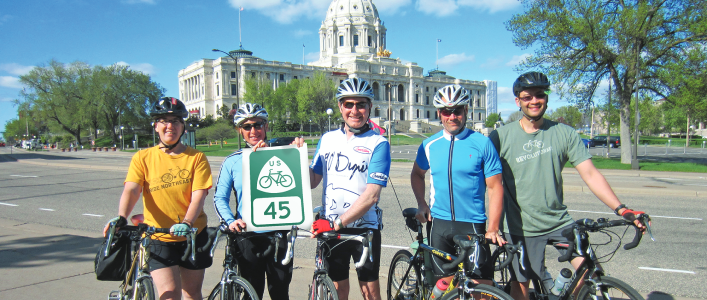
Guiding Documents
- USBRS Brochure (PDF) provides an overview of designating U.S. Bicycle Routes
- FAQs for Planners
- U.S. Bicycle Route System Purpose and Policy Statement (PDF) provides AASHTO’s guiding principles for the U.S. Bicycle Route System.
- National Corridor Plan is the overview map of proposed and designated routes.
- USBRS Corridor Criteria (PDF) defined by the AASHTO Task Force on U.S. Bicycle Routes.
- AASHTO meetings calendar
- Best Practices Reports (PDF): These two reports by Toole Design Group provide a series of case studies highlighting best practices from various states that have designated and promoted U.S. Bicycle Routes.
- Tips for Bikeway Designation (PDF) by Michael Jackson, former director of bicycle and pedestrian access for the Maryland Department of Transportation.
- International Bicycle Route Networks is a list of national and continental bike route networks found around the world.
- Economic Impact studies of bike tourism’s benefits to various countries, states, and trails.
Route Evaluation Criteria
- Adventure Cycling’s Route Criteria (PDF): Use our expertise for planning long distance routes using existing roadways and trails.
- Florida U.S. Bicycle Route Criteria (PDF): Developed by Florida and Georgia DOTs in cooperation with a number of non-profits and transportation agencies, this criteria provides more specific route considerations while providing enough flexibility for route development anywhere in the U.S.
- Wisconsin Rural Roadway Methodology (PDF, pages 13-15): Wisconsin’s Department of Transportation has been using this model, with slight modifications, for the past 28 years.
- Bike Pennsylvania’s route evaluation form (PDF): to learn more about Pennsylvania’s bike route network visit BikePA and Penn Highways Bike Routes.
- Rhode Island’s Bicycle Route Suitability Report (PDF)
- Michigan DOT’s roadway evaluation model for U.S. Bicycle Routes is available upon request.
- Kentucky’s Bicycle Comfort Index tool
Outreach Templates
- Michigan Trails and Greenways volunteer Scott Anderson created an outreach letter template (Word) that informs roadway managers and transportation agencies about the development of a USBR in their jurisdiction.
- Guide to Gaining Local Agency Support (PDF) is a model and planners can use a tracking spreadsheet which is available upon request.
- The Resolution of Support template (Word) and Letter of Support template (Word) can be used when local jurisdictions are ready to officially endorse a U.S. Bicycle Route.
- Presentation PowerPoint highlighting the USBRS and bicycle tourism is available upon request.
- A template letter/comments in support of including U.S. Bicycle Routes in state or regional bicycle & pedestrian plans is available on Advocacy Alerts & Letters.
Liability Information
The following documents address liability concerns and conclude that there is no inherent liability for local agencies in designating bicycle routes. Planners should supply local information when available.
- Liability Aspects Of Bikeway Designation (PDF) by John English. This document establishes cyclists as legitimate road users.
- NCHRP Legal Research Digest 53 (PDF) on liability and bikeway designation was published by the Transportation Research Board in 2010 and is considered an update to the John English report. This study notes an extremely low incidence of reported cases where a tort claim was filed specifically based on whether or not an agency designated a particular facility as a bikeway.
- Whose Roads? Evaluating Bicyclists’ and Pedestrians’ Right to Use Public Roadways (PDF): This report shows that non-motorized modes have clear legal rights to use public roads; non-motorized travel is important for an efficient transport system and provides significant benefits to users and society; less than half of roadway expenses are financed by motor vehicle user fees; and pedestrians and cyclists pay more than their share of roadway costs.
- Michigan Bicycle and Pedestrian Design and Liability Presentation (PDF) demonstrates how, under Michigan law, the pursuit of safe design for bicyclists and pedestrians poses no additional risk of liability.
- Tips for Bikeway Designation (PDF) by Michael Jackson, director of bicycle and pedestrian access for the Maryland Department of Transportation.